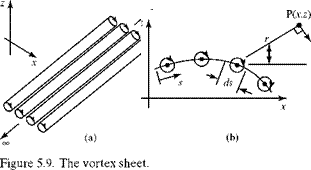The Vortex Sheet
The concept of the vortex sheet is central to thin-airfoil theory. A vortex sheet is a collection of vortex filaments, or threads, placed side by side. Each filament is
infinitesimal in strength and extends to ± infinity in a direction perpendicular to the x-z plane that contains the two-dimensional airfoil (Fig. 5.9(a)). The vortex filaments appear in cross section in the x-z plane as a series of point vortices (Fig. 5.9(b)). Notice that these coordinate axes depart from the simple (x, y) coordinates used in Chapter 4, which anticipates extension of the theory to the three-dimensional wing problem, as suggested in Fig. 5.1(a).
Recall that the velocity field associated with a single two-dimensional point vortex is everywhere perpendicular to a radius taken from the vortex as center. Thus, an isolated vortex may be thought of as inducing at a point of a velocity component that is at right angles to a line joining the center of the vortex to that point. The word inducing is emphasized because it is only a conceptual aid. The vortex does not cause a velocity; rather, a real vortical flow configures itself physically such that there is a viscous-dominated center and an associated velocity field with circular streamlines.
Referring to Fig. 5.9(b), let у = у(s) represent the strength of the vortex sheet per unit length along s. Thus, the strength of an infinitesimal segment of the sheet is the strength per unit length multiplied by the lengths—namely, уds. The vortex filaments contained within this small segment are combined and treated as a point vortex. These point vortices are assumed to rotate in a clockwise sense, as shown in Fig. 5.9. Recall from the definition of circulation, Eq. 4.8, and from Section 4.6 regarding a point vortex that for a vortex of finite strength with a clockwise sense, the vortex strength, Г, is positive and then
Г
Ue=- 2 nr
is negative. The notation for polar coordinates (Fig. 5.9(a)) thus indicates that the induced velocity ue is also in a clockwise sense. It follows that the velocity, dy, induced by a vortex filament is clockwise, as shown in Fig. 5.9(b), and that
![]()
 |
yds 2nr ’
where dy is the differential velocity induced by a small segment of the vortex sheet.
Now, we consider a line integral taken around a length ds of vortex sheet. By definition, Eq. 4.8:
Г = – ф v • ds
and integrating counterclockwise from Point A in Fig. 5.10:
dT = —(—uUds – v2dn + uLds + v dn),
where all of the velocity components around the path are assumed to be in the positive-coordinate directions. Letting dn — 0, this reduces to d Г = (uu – uL)ds.
Now, the strength of the segment of the vortex sheet contained within the closed path is y ds. Thus,
dГ = yds = (uU – uL)ds (5.2)
and y = (uu – uL). This result states that the local jump in tangential velocity across the vortex sheet at any point is precisely equal to the local sheet strength.











